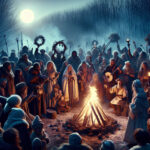Ostara is a Pagan holiday celebrated by many traditions around the world, and it has been celebrated for centuries. It is a time to honor the fertility of the land, to celebrate the coming of spring and to give thanks for the natural abundance of the earth. Ostara is a time for rebirth and renewal, for rejoicing in the change of the seasons and for reconnecting with the natural world. In this article, we will explore the history and traditions of this special time of year and how to celebrate the Pagan holiday of Ostara.

Ostara is a pagan holiday that celebrates the coming of spring. It is celebrated around the world by those who follow pagan traditions, and is often referred to by its other names, such as Eostre, the Spring Equinox, or the Vernal Equinox. This holiday typically takes place on the vernal equinox, which is the day when the sun crosses the celestial equator and the length of day and night is equal.
What Is the Meaning of Ostara?
Ostara is a celebration of the arrival of spring and the renewal of nature. It is said to be named after the goddess Eostre, who is associated with the dawn and the fertility of the land. The holiday is a time to celebrate the new beginnings of the season and the fertility of the land, as well as to give thanks and appreciation to the gods and goddesses of nature. It is also a time to celebrate fertility and abundance, as well as to give thanks for the blessings of the past year.
What Are Some Common Ostara Traditions?
Ostara is celebrated in a variety of ways, depending on the traditions and beliefs of the people who are celebrating. Common traditions include decorating eggs, planting gardens, and feasting on a variety of spring foods. It is also a time to give thanks to the gods and goddesses of nature for their blessings and the gifts of spring. Other common activities include gathering wildflowers and herbs, creating spring wreaths, and engaging in fertility rites.
What Are Some Common Symbols of Ostara?
Some of the most common symbols associated with Ostara include eggs, rabbits, and chicks. These symbols represent fertility, abundance, and rebirth. Other symbols associated with this holiday include flowers, spring green foliage, and the colors of the season. These colors typically include shades of yellow, pink, purple, and green.
How Is Ostara Celebrated?
Ostara is typically celebrated with a feast of spring foods and activities that focus on the renewal of nature. People often gather for a feast of spring foods, such as eggs, dairy products, and fruits. Other activities often include egg decorating, gardening, and crafting. Many people also take part in fertility rites and rituals, as well as rituals that focus on the balance of light and dark.
What Are Some Common Ostara Recipes?
Ostara feasts often include a variety of spring foods, such as eggs, dairy products, and fruits. Common recipes include egg-based dishes such as deviled eggs, egg salad, and quiches. Dairy products such as cheese, yogurt, and cream are also included in the feast, as well as fruits such as apples, pears, and berries. Other popular Ostara recipes include honey cakes, spring salads, and sweet treats such as cookies and cakes.
What Is the Significance of Ostara?
Ostara is a celebration of the renewal of nature and the abundance of spring. It is a time to give thanks for the gifts of the season and to enjoy the fertility of the land. This holiday is also a reminder of the balance between light and dark, and the importance of celebrating the gifts of life.
Ostara is a beautiful and joyous holiday that is celebrated by many Pagans around the world. It is a time to celebrate the renewal of life, the coming of spring, and to honor the goddess of fertility. It is a time to give thanks for the abundance of the Earth, to celebrate the cycles of nature, and to give thanks to the gods and goddesses for their blessings. Whether you celebrate Ostara with a ritual or just take the time to appreciate the beauty of nature, it is sure to be a memorable and meaningful experience. Ostara is a time to reflect and give thanks for the gifts of nature and the blessings of the gods and goddesses.





